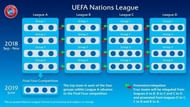Come 2018, international friendlies are going to be a thing of the past. While we all hate international breaks with their tendencies to spring multiple injuries to several top stars and an even tighter fixture congestion for the players, they do seem to catch the eye whenever a mouth-watering match presents itself.
While the coming international break is of paramount importance to several top teams with the World Cup futures of most of the teams from Europe and South America to be decided, most international breaks are strewn with meaningless friendlies where most of them bear a clear gulf in rankings and class between the two sides.
But gone are the days when France taking on Andorra used to be nothing more than an injury-scare for fans around the globe for their favourite superstars, at least for the fans in Europe.
It is all about to change come next year when UEFA's international version of the Champions League, Nations League kicks off. Let's take a look at what to expect of the UEFA's bid to revitalize international football.
#1 How is it going to pan out?

As the name suggests, the competition follows a league based system where the 55 UEFA member teams will play in a 4-division league system named League A, B, C and D. The division of these leagues is solely based on the UEFA coefficient rankings.
The top 12 highest ranked teams qualify directly for the 1st division, League A, where they are then split into a further 4 groups of 3 teams each which will play one another in the international breaks of the winter of 2018 over two-legged home away ties.
The 4 group winners will then play out single legged semifinals at a neutral venue in June 2019, winners of which will compete to be the first UEFA Nations League Champions.
The Leagues B, C and D consist of the next 12, 15 and 16 best teams respectively. The three lower leagues are also divided into 4 groups and follow the same pattern of matches. The lower leagues will fight it out for promotion while higher leagues will have to be wary of promotion as 4 teams will switch after each edition to the higher or lower league.
The bottom-most team of each group goes down to the corresponding group of the lower league whose winner is promoted to the upper division.
#2 Who goes where?

As things stand, the inaugural edition of UEFA Nations League 2018 could line up this way-
LEAGUE A (teams to be split into four groups of three)
Germany, Portugal, Belgium, Spain, Switzerland, France, England, Italy, Poland, Croatia, Iceland, Wales.
LEAGUE B (teams to be split into four groups of three)
Russia, Northern Ireland, Slovakia, Sweden, Netherlands, Ukraine, Bosnia and Herzegovina, Austria, Turkey, Republic of Ireland, Denmark, Hungary.
LEAGUE C (teams to be split into one group of three, and three groups of four)
Slovenia, Albania, Montenegro, Serbia, Scotland, Czech Republic, Romania, Greece, Bulgaria, Israel, Norway, Cyprus, Finland, Estonia, Azerbaijan.
LEAGUE D (teams to be split into four groups of four)
Lithuania, Belarus, Georgia, Armenia, FYR Macedonia, Faroe Islands, Luxembourg, Latvia, Moldova, Kazakhstan, Liechtenstein, Andorra, Malta, Kosovo, San Marino, Gibraltar.
The top division promises a series of blockbuster clashes with several World Cup knockout stage regulars expected to be grouped together. These are probable lineups and this week's international break provides the last chance for teams to make a move in the UEFA rankings with the draw slated to be in January 2018.
One of the biggest omission from the top division, the current World cup semi-finalists, Netherlands have their task cut out. The Dutch have two difficult matches against Belarus and Sweden to navigate. A slip up against either two could cost them their ticket to both the World Cup and the first division of the Nations League.
#3 What's up for grabs?

With the expansion of Euros set to take place, the 24-nation Euros will have 20 teams qualifying through the traditional 10 qualifying groups in the early part of 2019. The 4 additional places will be filled up by the 4 League winners, thus providing the teams in League D to be a part of the continent's biggest competition.
The 4 group winners of each league will compete much in the same way as the League A group winners will be for the title.
But if any of the group winners from a league has qualified already, the next best team in that whole league, and not from its group, would be chosen. In case there are less than 4 teams unqualified in a league, which is much likely in Group A, the fifth-best team from the lower division will get a chance to compete for the spot in the 24-nation finals of the European Championships.
#4 Where does it fit in?

With all the talk of burn-out and fixture congestion complaints from managers and players alike, does a highly competitive tournament where national pride is at stake make the schedule even more demanding? Not really. The competition is scheduled according to the existing International breaks and rather than the players, the more direct victims are likely to be the friendlies.
The group stages of all the four league will happen in the existing international breaks in September, October and November. While the level of the contest is likely to be high in the matches, fixture congestion isn't likely. The finals and the Euro qualifying matches are scheduled for the end of the 2018-19 season in June, after the direct European qualifiers for the 2020 Euro Championships are done and dusted.
#5 Should you be excited?

While it's not something which is going to make everyone wait for the international break, its a step in the right direction to bring some interest and importance back to international football. The quality of contests is likely to go up with the lower ranked European teams having a better opportunity to improve playing regularly on a level playing field.
A draw against a lower-ranked team does much good to your game and confidence than a series of 4-0, 5-0 hammerings at the hands of the big boys.
The viewers too can have great matches to watch out for in the international breaks with League A sure to invite interest.
And while the European teams stand to benefit, its a loss for the teams from Asia and Americas which would be devoid of the opportunity to compete against better teams. Japan, Korea, Mexico and Iran, teams that are too good for their Confederations won't be able to regularly compete against the world's best sides. And while it doesn't help the players with the scheduling, we as viewers are sure to be treated to wonderful football.
